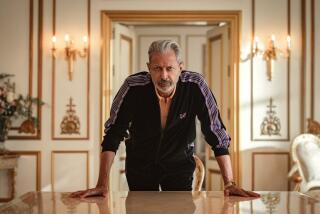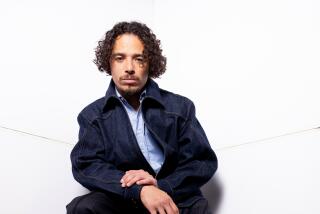âCloud Atlasâ filmmakers follow a new road map to adaptation
NEW YORK â As they swept through airports while making their ambitious, risky new movie, âCloud Atlas,â directors Andy and Lana Wachowski got used to answering a surprisingly tough question from customs officials.
âTheyâd say, âWhatâs your movie about?ââ said Andy. âItâs about the sum of human experience. They always look up and go, âOh, reallyâŚââ
âOur target audience is customs officials,â whispered Lana.
PHOTOS: Scenes from âCloud Atlasâ
Actually, their target audience is grown-ups.
The Wachowski siblings made âCloud Atlasâ together with German director Tom Tykwer. If filmmaking were an Olympic sport, the trio would score maximum difficulty points for even attempting the project â their script, adapted from British author David Mitchellâs bestselling, puzzle-like 2004 novel, vaults through six interwoven story lines spanning some 500 years and several genres, from a 19th century sea yarn to a 20th century thriller to a post-apocalyptic romance. âHangover 2â it is not.
The movieâs sprawling narrative and independently financed $102-million budget required its three filmmakers to embark on a rocky, six-year search for financing and ultimately shoot on two sets at the same time, one helmed by the Wachowskis, the other by Tykwer.
MORE: A legend for âCloud Atlasâ
Their hopes for the movie have also inspired the Wachowskis to overcome their long-standing aversion to press â in early October, the three directors gathered in Tykwerâs New York hotel room to explain their quixotic quest to make âCloud Atlas,â which opens Oct. 26. All three share an earnestness and a sibling-like tendency to finish one anotherâs sentences â even Tykwer, who was 34 when he met the Wachowskis.
Lana, 47, has been on her own personal journey â she is transgender and until 2002 was called Larry. Bubbly and stylish, with fuchsia dreadlocks, black boots and a soft, breathy voice, she seems to be the spiritual leader of the group; Lanaâs younger brother, Andy, 44, is bald and barrel-chested and warier than his sister to talk but acerbically funny when he does; Tykwer, 47, is cerebral and handsome, with a heavy German accent.
The threesome share similar origins stories. All started making short films as children â the Wachowskis, born in Chicago, found jobs in carpentry and comic books before they directed their first feature, âBound,â in 1996; Tykwer, born in Wuppertal, Germany, worked as a theater projectionist before his first feature, âDeadly Maria,â came out in 1993.
Friends since 1999, when Tykwerâs defining crime thriller âRun Lola Runâ opened in the U.S. within a few months of the Wachowskisâ now iconic sci-fi action movie âThe Matrix,â the filmmakers had stayed in touch over the years, looking for a project to share. When Lana read âCloud Atlasâ in 2005, she saw in it the potential of deep-think, big-canvas films she and her brother had loved in their youth, like â2001: A Space Odyssey,â and recommended the book to Andy and Tykwer.
âThere was a time when movies were funny and sad and dramatic and slapsticky and challenging and thought-provoking all at the same time,â said Lana. âThat would be one movie. Now you break that all up into a comedy, a romance, a drama. With âCloud Atlasâ we were thinking, âIt could be everything.ââ
âWe felt like, because itâs so challenging it will need three directors,â said Tykwer. âIt will help to have three minds!â
They put their minds together to tackle âCloud Atlasââ complex structure, but it was Lana, inspired by a line in the book in which a character disdains âflashbacks and flashforwards and other tricksy gimmicks,â who first came up with the solution. In the novel, the six interconnected stories unfold chronologically, until the middle of the book, where the sequence reverses.
The unusual architecture of the story is part of the pleasure of reading âCloud Atlas,â but itâs also what made the book seem unfilmable â who would want to watch characters for 20 minutes who then disappear for two hours? Instead, Lana proposed to her co-writers a structure in which all of the stories unravel concurrently and wrote the first 10 minutes of the film this way to persuade them.
To help clarify the bookâs underlying metaphysical themes, the directors came up with another âtricksy gimmickâ â having their actors, who include Tom Hanks, Halle Berry, Hugh Grant and Korean star Doona Bae, each play multiple roles. Sometimes they portray different races and genders.
âWe wanted this feeling that weâd get the dissolution of borders and boundaries,â Lana said. âThe whole system of understanding what the other is â man, woman, white, black, Western, Asian â there are all these barriers to understanding the human-ness thatâs underneath these distinctions.â
The filmmakers were able to attract name actors such as Hanks and Berry because the stars would get to play multiple intriguing roles. Financiers were a tougher sell.
âPeople were blown away by the concept and blown away by the cast, but they wouldnât give us any money,â Andy said.
âBecause there is no comparison,â said Tykwer. âDistributors need comparison. They need to say, here are at least three movies that are quite like this and they didnât find one.... The whole idea of originality is scary, especially if it goes into this larger-scale production.â
Once in a rare while, a movie with a complex plot hits big â such as Christopher Nolanâs âInception,â which earned $292 million at the U.S. box office. But more often, like Darren Aronofskyâs âThe Fountain,â which earned $10 million, or Alejandro Gonzalez Inarrituâs âBabel,â which collected $35 million, a baroque or unconventional narrative attracts a more limited audience.
PHOTOS: Scenes from âCloud Atlasâ
Nevertheless, together with their producers, the filmmakers assembled financing from Warner Bros., which holds the North American rights, various Asian and European sources and the Wachowskisâ own pockets. According to producer Grant Hill, on three occasions a key element of the financing fell through.
âIt was really a game of chicken,â Hill said. âThere were times where we sat down and said, âShould we keep going forward? This is too risky, too hard.â
With financing finally intact, they began shooting in September 2011, working in Germany, Scotland and the Spanish island of Majorca. The Wachowskis took responsibility for an 1849 sea story and two future-set tales, and Tykwer handled an early 20th century composerâs life, a 1973 thriller and a contemporary caper about an aging book publisher. Each of the two units had its own director of photography, production designer, costume designer and makeup supervisor â department heads who are usually atop their own little pyramids. But the goal was to make the movie feel stylistically whole, so the teams had to agree together on decisions like which lenses to use and which settings like bridges and trains should recur in several stories.
MORE: A legend for âCloud Atlasâ
While shooting, the directors communicated with each other via Skype to be sure they would be able to intercut their scenes seamlessly, holding up their iPads to demonstrate a camera angle, for instance.
For the actors, answering to three directors with three visions could have been dizzying, but Hanks, who performs a character in all six time periods, said the direction he got was remarkably consistent.
âI called Lana and Andy mom and dad after a while because we were always looking to mom and dad for approval,â Hanks said. âYou could see when you were on the track or when you were searching for something.... They were all as fluid as one individual. There wasnât a moment of confusion or tension or hesitancy.â
Tykwer, who is also a composer, wrote the music for the film with his regular collaborators Johnny Klimek and Reinhold Heil â a task that included crafting âThe Cloud Atlas Sextet,â a piece of classical music that is also a major plot point in the composerâs story.
After editing the movie side by side in marathon sessions in Berlin this year, the directors brought their nearly three-hour cut to the Toronto International Film Festival last month, where it premiered to a long-standing ovation but garnered mixed reviews. Critics praised the film as impressive in its reach but messy in its execution.
The directorsâ next step may be the hardest yet, however â attracting a broad audience to a movie that asks a lot of its viewers.
âWeâre hoping the audience is there,â said Lana. âWe want everyone not only to enjoy it but to be challenged by it and stimulated by it. Itâs great when people see a movie, but itâs better when they spend the whole day talking about it.â
PHOTOS AND MORE:
PHOTOS: Hollywood back lot moments
Latest movie reviews
PHOTOS: NC-17 movies: Why they got the rating
More to Read
Only good movies
Get the Indie Focus newsletter, Mark Olsen's weekly guide to the world of cinema.
You may occasionally receive promotional content from the Los Angeles Times.











